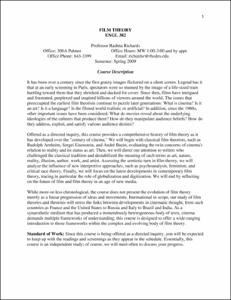Please use this identifier to cite or link to this item:
http://hdl.handle.net/10267/3490Full metadata record
| DC Field | Value | Language |
|---|---|---|
| dc.contributor.author | Richards, Rashna | - |
| dc.date.accessioned | 2009-02-20T19:06:01Z | - |
| dc.date.available | 2009-02-20T19:06:01Z | - |
| dc.date.issued | 2009-01-14 | - |
| dc.identifier.uri | http://hdl.handle.net/10267/3490 | - |
| dc.description | This syllabus was submitted to the Office of Academic Affairs by the course instructor. | en_US |
| dc.description.abstract | It has been over a century since the first grainy images flickered on a silent screen. Legend has it that at an early screening in Paris, spectators were so stunned by the image of a life-sized train hurtling toward them that they shrieked and ducked for cover. Since then, films have intrigued and frustrated, perplexed and inspired billions of viewers around the world. The issues that preoccupied the earliest film theorists continue to puzzle later generations: What is cinema? Is it an art? Is it a language? Is the filmed world realistic or artificial? In addition, since the 1960s, other important issues have been considered: What do movies reveal about the underlying ideologies of the cultures that produce them? How do they manipulate audience beliefs? How do they address, exploit, and satisfy various audience desires? Offered as a directed inquiry, this course provides a comprehensive history of film theory as it has developed over the "century of cinema." We will begin with classical film theorists, such as Rudolph Arnheim, Sergei Eisenstein, and André Bazin, evaluating the twin concerns of cinema's relation to reality and its status as art. Then, we will direct our attention to writers who challenged the classical tradition and destabilized the meaning of such terms as art, nature, reality, illusion, author, work, and artist. Assessing the semiotic turn in film theory, we will analyze the influence of new interpretive approaches, such as psychoanalysis, feminism, and critical race theory. Finally, we will focus on the latest developments in contemporary film theory, tracing in particular the role of globalization and digitization. We will end by reflecting on the future of film and film theory in an age of new media. While more-or-less chronological, the course does not present the evolution of film theory merely as a linear progression of ideas and movements. International in scope, our study of film theories and theorists will stress the links between developments in cinematic thought, from such countries as France and the United States to Russia and Italy to Brazil and India. As a synaesthetic medium that has produced a tremendously heterogeneous body of texts, cinema demands multiple frameworks of understanding; this course is designed to offer a wide-ranging introduction to those frameworks within the complex and evolving body of film theory. | en_US |
| dc.language.iso | en_US | en_US |
| dc.publisher | Memphis, Tenn. : Rhodes College | en_US |
| dc.relation.ispartofseries | Syllabi CRN | - |
| dc.rights | Rhodes College owns the rights to the digital objects in this collection. Objects are made available for educational use only and may not be used for any non-educational or commercial purpose. Approved educational uses include private research and scholarship, teaching, and student projects. For additional information please contact archives@rhodes.edu. Fees may apply. | - |
| dc.subject | English, Department of | en_US |
| dc.subject | Syllabus | en_US |
| dc.subject | Curriculum | en_US |
| dc.subject | Academic departments | en_US |
| dc.subject | Text | en_US |
| dc.subject | 2009 Spring | en_US |
| dc.title | ENGL 382-01, Film Theory, Spring 2009 | en_US |
| dc.type | Syllabus | en_US |
| Appears in Collections: | Course Syllabi | |
Files in This Item:
| File | Description | Size | Format | |
|---|---|---|---|---|
| 2009_SP_ENGL_382.pdf | 34.19 kB | Adobe PDF |  View/Open |
Items in DSpace are protected by copyright, with all rights reserved, unless otherwise indicated.